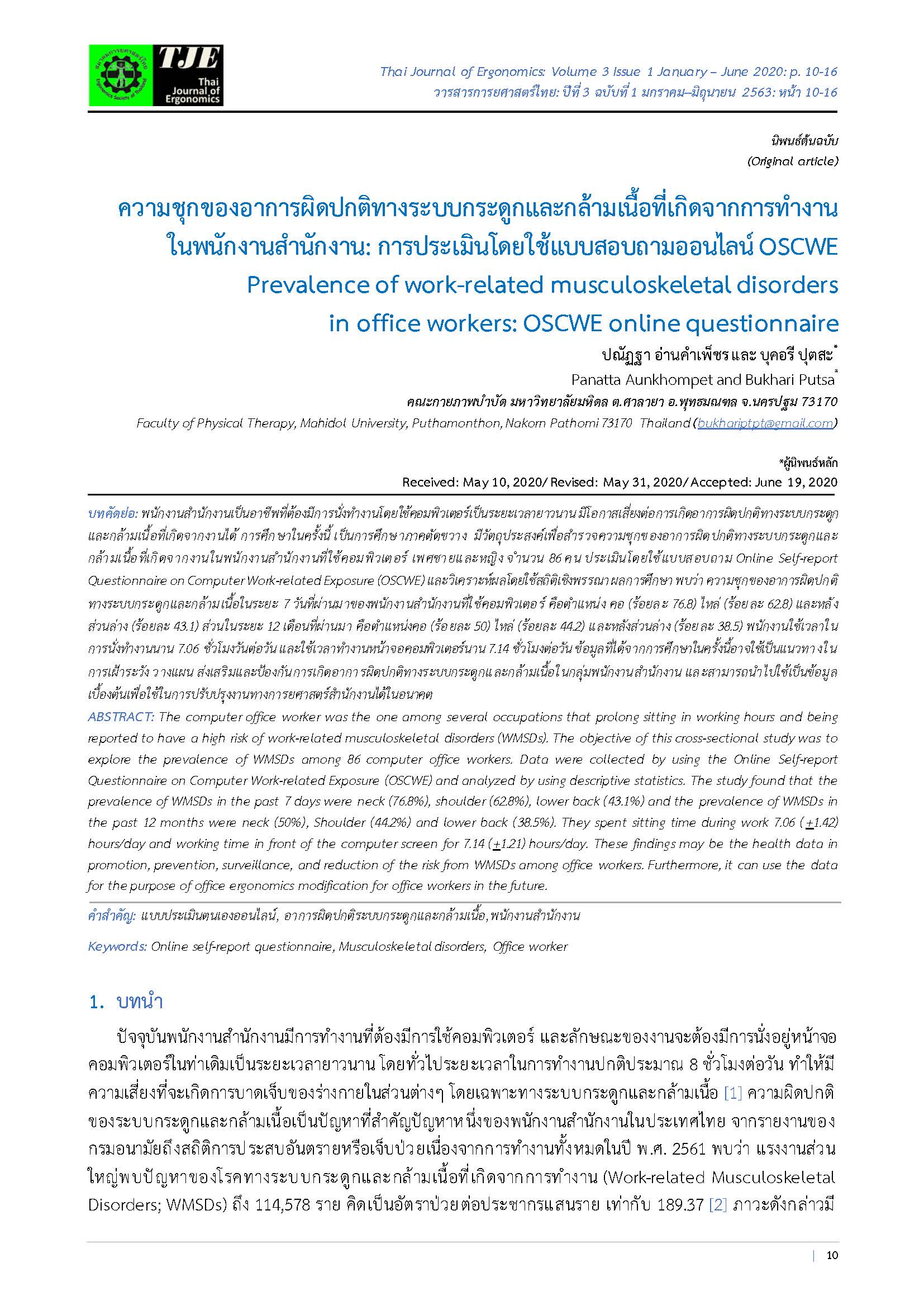Prevalence of work-related musculoskeletal disorders in office workers: OSCWE online questionnaire
Main Article Content
Abstract
The computer office worker was the one among several occupations that prolong sitting in working hours and being reported to have a high risk of work-related musculoskeletal disorders (WMSDs). The objective of this cross-sectional study was to explore the prevalence of WMSDs among 86 computer office workers. Data were collected by using the Online Self-report Questionnaire on Computer Work-related Exposure (OSCWE) and analyzed by using descriptive statistics. The study found that the prevalence of WMSDs in the past 7 days were neck (76.8%), shoulder (62.8%), lower back (43.1%) and the prevalence of WMSDs in the past 12 months were neck (50%), Shoulder (44.2%) and lower back (38.5%). They spent sitting time during work 7.06 (+1.42) hours/day and working time in front of the computer screen for 7.14 (+1.21) hours/day. These findings may be the health data in promotion, prevention, surveillance, and reduction of the risk from WMSDs among office workers. Furthermore, it can use the data for the purpose of office ergonomics modification for office workers in the future.
Article Details

This work is licensed under a Creative Commons Attribution-NonCommercial-NoDerivatives 4.0 International License.
References
Wu S, He L, Li J, Wang J, Wang S. Visual display terminal use increases the prevalence and risk of work-related musculoskeletal disorders among Chinese office workers: a cross-sectional study. J Occup Health. 2012; 54(1): 34‐43. doi:10.1539/joh.11-0119-oa
กองโรคจากการประกอบอาชีพและสิ่งแวดล้อม กรมควบคุมโรค กระทรวงสาธารณสุข. รายงานสถานการณ์โรคและภัยสุขภาพจากการประกอบอาชีพและสิ่งแวดล้อม ปี 2561. 2561; หน้า 3-4 [เข้าถึงเมื่อ 19 กันยายน 2562] Available from: http://envocc.ddc.moph.go.th/contents?g=11
Bernard BP, Putz-Anderson V. Musculoskeletal disorders and workplace factors; a critical review of epidemiologic evidence for work-related musculoskeletal disorders of the neck, upper extremity, and low back. 1997.
Valipour Noroozi M, Hajibabaei M, Saki A, Memari Z. Prevalence of Musculoskeletal Disorders Among Office Workers, Jundishapur J Health Sci. 2015; 7(1):e27157. doi: 10.5812/jjhs.27157.
Kuorinka I, Jonsson B, Kilbom A, et al. Standardised Nordic questionnaires for the analysis of musculoskeletal symptoms. Appl Ergon. 1987; 18(3): 233‐237. doi: 10.1016/0003-6870(87)90010-x
Browne CD, Nolan BM, Faithfull DK. Occupational repetition strain injuries. Guidelines for diagnosis and management. Med J Aust. 1984; 140(6): 329‐332.
Mekhora K, Jalayondeja W, Jalayondeja C, Bhuanantanondh P, Dusadiisariyavong A, Upiriyasakul R, Anuraktam K. Online self-report questionnaire on computer work-related exposure (OSCWE): Validity and internal consistency. J Med Assoc Thai. 2014; 97 (Suppl.7): S80-S83
Janwantanakul P, Pensri P, Jiamjarasrangsri V, Sinsongsook T. Prevalence of self-reported musculoskeletal symptoms among office workers. Occup Med (Lond). 2008;58(6):436‐438. doi: 10.1093/occmed/kqn072
Cagnie B, Danneels L, Van Tiggelen D, De Loose V, Cambier D. Individual and work related risk factors for neck pain among office workers: a cross sectional study. Eur Spine J. 2007; 16(5): 679‐686. doi: 10.1007/s00586-006-0269-7
Ariëns GA, Bongers PM, Douwes M, et al. Are neck flexion, neck rotation, and sitting at work risk factors for neck pain? Results of a prospective cohort study. Occup Environ Med. 2001; 58(3): 200‐207. doi: 10.1136/oem.58.3.200
Wahlström J. Ergonomics, musculoskeletal disorders and computer work. Occup Med (Lond). 2005; 55(3): 168‐176. doi: 10.1093/occmed/kqi083


